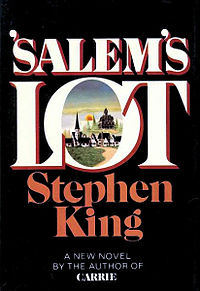Doubleday, Hardcover, 1975, $25.00, 451pp
ISBN: 0-385-00751-5
This review of Salem’s Lot has been a long time coming just like the one on The Shining. Of course, I wasn’t writing book reviews when the novel first came out so I should be granted a little slack with regards to the time frame.
Before I delve into the review, I want to admit to having two copies of Salem’s Lot. I wish I could say one of them was an autographed first edition, but it isn’t. Instead, I have two very fine, readable editions for my bookshelf. One of them is the very attractive Illustrated Edition that Doubleday put out in 2005. This includes the novel, the two short stories (One For the Road & Jerusalem’s Lot), thirty pages of deleted scenes, and several rather eerie photographs by Jerry Uelsmann. The book is heavy, weighing almost as much as Under the Dome. Because of the weight, I chose the second of my two editions to read—the one published in the late nineties with a cover jacket design and collage by Thomas Holdorf and Peter Kruzan, and red lettering by Craig De Camp. I really like this jacket design, and it’s similar to one on The Shining. Doubleday published all six of their Stephen King novels with matching jackets by these men. They look great and are certainly much better than the original designs. You have to be careful, however, in ordering them online. You may pay full jacket price, thinking you’re getting this special designed cover, only to receive books with the original jackets on them. This has happened to me more than once. Right now I have Salem’s Lot, The Shining, and The Stand with the matching covers. That’s okay. Those are the main novels I wanted.
As all of you probably know by now, either from reading the novel or watching the two different television mini-series based on the book, the story deals with author, Ben Mears (Stephen King described the character’s appearance from his own), returning to the town where he lived as a teenager and had the most horrific experience of his life…that is up until his return to Jerusalem’s Lot, or Salem’s Lot as it’s called by the town’s people. He’s come back to write a new novel about the haunted Marsten House that overlooks the small community from a hill. The timing for Ben couldn’t have been more perfect because two other visitors have also just moved there, buying the Marsten House and opening an antique furniture store in town.
It isn’t long before children and adults start disappearing from the Lot only to return again, but this time as blood-sucking creatures of the night. The owner of the Marsten House is named Barlow, and his henchman is called Straker. Barlow has lived for hundreds of years, surviving by relocating around the world and assuming a new name. You see, Barlow’s a vampire, and not the kind you read about in the Twilight series. This vampire is the real thing, if such a thing actually does exist. There are no sexual innuendos here or teenage turmoil founded in true love. No, sir. Barlow is the kind of vampire who goes straight for the jugular rather than piddling around, mooning over a young girl he can’t have.
Eventually, Mears with the help of teenager, Mark Petrie, and English teacher, Matt Burke, and doctor, Jimmy Cody, go after the vampires with stakes, crosses, and holy water. What they set about doing isn’t pleasant to read, nor should it be. This is exactly what it would be like in real life. Barlow, however, has no intention of going down without a fight. He has survived too long to give up with just a few measly human beings after him.
In many ways I feel this is the novel that started it. Not Carrie, but Salem’s Lot. The author, Stephen King, gives us a firsthand look at what it would be like if a vampire set his eyes on a small New England town like the one in Peyton Place. He wouldn’t have much of a problem in taking over the populace, biting a few people at a time with no one guessing the true nature of the epidemic. Few outside communities would even be aware of what was happening miles from the edge of their borders. Remember, this novel was written in 1975 before the invention of the Internet, cell phones, and Tweeting. In many ways, I consider Salem’s Lot to be the most realistic of modern horror novels. If vampires existed, something like this could easily take place because no one would believe it. Often, it’s our disbelief in something that brings about our own down fall.
Another thing about Salem’s Lot is the quality of writing by Stephen King. This is a writer who was way ahead of his time with his skills as a words’ smith. King knows how to write a scene dripping with dark, menacing atmosphere. He knows how to juggle dozens of characters around in a story, bringing them to life with a few short descriptive words. He knows how to pace a long novel, giving the reader a reprieve from the horror aspects of the story, and then socking it to him or her again and again. Even at twenty-seven, King was already a master of the written word and could tell a story that would keep you up at nights. This is what great storytelling is about. It’s no wonder the late John D. MacDonald gave this author such high kudos for his writing skills in the introduction to Night Shift. Stephen King was already there as a writer with a shining (no pun intended) future ahead of him.
Salem’s Lot, The Shining, and The Stand are the mainstay of my library. For me, this is what began my strong interest in the horror genre and wanting to be a writer like Stephen King. If you’re a fan of horror fiction, then this novel should be up on your bookshelf. End of story. Your library isn’t complete without Salem’s Lot in it.
One last note and then I’m gone. Any reader who hasn’t read Salem’s Lot can certainly get the paperback version for several bucks. As a small-time collector, I choose to have hardcovers whenever I can afford it.

